M
I
C
R
O
S
T
O
R
Y
O
F
A
R
T
........................................................

NOW COMPLETED:

........................................................
MICROSTORY OF ART
ONLINE JOURNAL FOR ART, CONNOISSEURSHIP
AND CULTURAL JOURNALISM
........................................................
INDEX | PINBOARD | MICROSTORIES |
FEATURES | SPECIAL EDITIONS |
HISTORY AND THEORY OF ATTRIBUTION |
ETHNOGRAPHY OF CONNOISSEURSHIP |
SEARCH

........................................................



 >MICROSTORIES
>MICROSTORIES
- Richard Serra
- Martin Scorsese
- Claude Simon
- Sunshine
- Werner Herzog
- The Creation
- Marcel Duchamp
- Nino Rota
- Wölfflin and Woolf
- Hansjörg Schneider
- Kraftort Arkadien
- Visual Biography
- Schlaraffenleben
- Die Geisteswissenschaften
- The Voyeur
- Buzzword Sustainability
- Paul Verlaine
- Tao Yuanming
- New Beginning
- Seneca
- Still Lifes
- Charles Baudelaire
- Frédéric Chopin
- The Art History of Sustainability
- Wang Wei
- Solarpunk
- Historians of Light
- Lepanto
- Renaturalization
- Plates
- Snow in Provence
- Learning to See
- Picasso Dictionaries
- Peach Blossom Spring
- Picasso Tourism
- Tipping Points
- Sviatoslav Richter
- Weather Reports
- Treasure Hunt
- Another Snowscape in Picasso
- Picasso in 2023
- Dragon Veins
- The Gloomy Day
- The Art of the Pentimento
- Reforestation
- The Status of Painting
- Emergency Supply
- Punctuality
- Watching Traffic
- Zhong Kui
- How Painting Survived the 1990s
- Confirmation Bias
- Sustainability and Luxury
- Garage Bands
- Picasso and Artificial Intelligence
- Eyes of Tomorrow
- Picasso in 2023 2
- Gluing Oneself to Something
- Suburbia
- Bamboo
- Sustainability and Carpe Diem 1
- Interviews with Bruegel
- Sustainability and Carpe Diem 2
- Coffee & Sugar
- Bamboo 2
- Picasso in 2023 3
- Sustainability and Carpe Diem 3
- Cherry Orchard
- Old Magazines
- Chance
- Nick Drake
- Harlequin
- The Smartphone & the Art Book
- Atlas Syndrome
- The Kitchen
- Atlas Syndrome 2
- Consideration
- Tori Amos
- School
- Orchard Auctioning Day
- The Hundred Years’ War
- Sócrates
- Chameleon
- Nefertiti Bust
- Picasso as a Computer
- Sunflowers
- Philemon & Baucis
- Ode to the Radio
- Childhood
- Wimmelbild
- Restitution
- Nick Drake 2
- Wishful Thinking
- Sundays
- The Independent Scholar
- September
- The Fisherman by Pirosmani
- Microadventure
- Sociology
- Salvator Mundi
- Chillon
- Appassionata
- Amber
- Homer
- Berlin
- Planet Walk
- Improvisation
- Seeing Picasso
- These Nice Kids
- Robber
- The One
- The Sea Turtle
- Zoo
- Through the Hush
- Wunderkammer
- I Do Not Seek, I Find
- Shopping Mall
- Food Hamper
- The Secretary
- This Gate
- Nor Rainy Day
- House on a Hill
- Beautiful Island
- Second-hand Bookstore
- Flat
- Slap in the Face
- Serra, Wenkenpark
- Apologies
- The Bells
- Nordmann Fir
- Picasso Wanting To Be Poor
- Picasso, Pirosmani
- A Brief History of Sculpture
- 24 Sunsets
- Rusty Phoenix
- Glove
- Wintry Stanza
- A Song
- Like A Beatle
- Catching An Orange
- Solar Bees
- Permaculture

 >FEATURES
>FEATURES
- Van Gogh On Connoisseurship
- Two Museum’s Men
- Ende Pintrix and the City in Flames
- Titian, Leonardo and the Blue Hour
- The Man with the Golden Helmet: a documentation
- Un Jury d’admission à l’expertise
- Learning to See in Hitler’s Munich
- Leonardo da Vinci and Switzerland
- The Blue Hour Continued
- The Blue Hour in Louis Malle
- Kafka in the Blue Hour
- Blue Matisse
- Blue Hours of Hamburg and LA
- A Brief History of the Cranberry
- The Other Liberale in the House
- The Blue Hour in Raphael
- Who Did Invent the Blue Hour?
- Monet on Sustainability
- Velázquez and Sustainability
- The Blue Hour in Guillaume Apollinaire
- Van Gogh on Sustainability
- The Blue Hour in Marcel Proust
- Picasso and Sustainability
- The Contemporary Blue Hour
- The Blue Hour in 1492
- The Blue Hour in Hopper and Rothko
- Hopper and Sustainability
- The Blue Hour in Ecotopia
- The Hour Blue in Joan Mitchell
- Explaining the Twilight
- The Twilight of Thaw
- The Blue Hour in Pierre Bonnard
- Explaining the Twilight 2
- Picasso on Stalin
- Rubens on Sustainability
- The Salvator Mundi in Bruegel and Rubens
- The Blue Hour in Leonardo da Vinci and Poussin
- The Blue Hour in Rimbaud
- Faking the Dawn
- Frost and Thaw in Ilya Ehrenburg
- Picasso, Stalin, Beria
- Picasso, Solzhenitsyn and the Gulag
- Shostakovich on Picasso
- Hélène Parmelin in 1956
- Historians of Picasso Blue
- Picasso Travelling to Moscow 1
- The Blue Hour in Caravaggio
- Picasso Travelling to Moscow 2
- Picasso, the Knife Game and the Unsettling in Art
- Some Notes on Leonardo da Vinci and Slavery
- Picasso Moving to the Swiss Goldcoast
- The Blue Hour in Camus
- The Blue Hour in Symbolism and Surrealism
- Caspar David Friedrich in His Element
- Exhibiting the Northern Light
- Caspar David Friedrich in His Element 2
- Robert Schumann and the History of the Nocturne
- The Blue Hour in Robert Schumann
- Caspar David Friedrich and Sustainability
- The Twilight of Thaw 2
- Multicultural Twilight
- The Blue Hour in Anton Chekhov
- The Blue Hour in Medieval Art
- Twilight Photography
- The Blue Hour in Bob Dylan
- Iconography of Optimism

 >SPECIAL EDITIONS
>SPECIAL EDITIONS
- Visions of Cosmopolis
- Mona Lisa Landscapes
- Turner and Ruskin at Rheinfelden
- Painters On TV & On TV
- Spazzacamini in Art
- A Last Glance at Le Jardin de Daubigny
- The Experimental Cicerone
- A Dictionary of Imaginary Art Historical Works
- Iconography of Blogging
- Begegnung auf dem Münsterplatz
- Cecom
- Das Projekt Visual Apprenticeship
- Those Who See More
- A Fox on Seeing with the Heart
- Sammlung Werner Weisbach
- Daubigny Revisited
- Some Salvator Mundi Microstories
- Some Salvator Mundi Afterthougths
- Some Salvator Mundi Variations
- Some Salvator Mundi Revisions
- A Salvator Mundi Questionnaire
- A Salvator Mundi Puzzle
- Unknown Melzi
- Francis I and the Crown of Charlemagne
- From Amboise to Fontainebleau
- Drones Above Chambord
- Looking Back At Conques
- Flaubert At Fontainebleau
- Images of Imperial Ideology
- The Chronicles of Santa Maria delle Grazie
- Seeing Right Through Someone
- Melzi the Secretary
- Eying Glass
- A Foil to the Mona Lisa
- A Renaissance of the Cartoon
- Sketching a Family Tree
- Venetian Variations
- A Brief History of Digital Restoring
- A Consortium of Painters
- Leonardeschi and Landscape
- A Christ in Profile
- Learning to See in Spanish Milan
- A History of Gestures
- Leonardo and Josquin
- A Renaissance of the Hybrid
- Suida and Heydenreich
- The Watershed
- Three Veils
- From Beginning to End
- Connoisseurship of AI
- Twilight and Enlightenment
- The Blue Hour in Chinese Painting
- Dusk and Dawn at La Californie
- Iconography of Sustainability
- The Blue Hour in Goethe and Stendhal
- The Sky in Verlaine
- The Blue Hour in Paul Klee
- Iconography of Sustainability 2
- The Blue Hour in Charles Baudelaire
- From Bruegel to Solarpunk
- Some Salvator Mundi Documentaries
- Some More Salvator Mundi Monkey Business
- The Windsor Sleeve
- Brigitte Bardot’s Encounter with Picasso
- Art Historians and Historians
- A Salvator Mundi Chronicle
- The Salvator Mundi and the French Revolution
- The Fontainebleau Group
- The Encounter of Harry Truman with Pablo Picasso
- The Fontainebleau Group Continued
- The Windsor Sleeve Continued
- The Salvator Mundi in Early Netherlandish Painting 1
- Some Salvator Mundi Resources
- A New Salvator Mundi Questionnaire
- The Woman in Picasso
- The Yarborough Group
- Melzi, Figino and the Mona Lisa
- The Yarborough Group Continued
- A Salvator Mundi Global History
- The Salvator Mundi in Medieval Art
- The Salvator Mundi in Medieval Art 2
- The Salvator Mundi in Early Netherlandish Painting 2


 >HISTORY AND THEORY OF ATTRIBUTION
>HISTORY AND THEORY OF ATTRIBUTION
- The Mysterious »Donna Laura Minghetti-Leonardo«
- Assorted Demons of Connoisseurship
- Panofsky Meets Morelli
- Discovering the Eye of Sherlock Holmes
- Handling the Left-handed Hatchings Argument
- Visual History of Connoisseurship
- Alexander Perrig
- Connoisseurship in 2666
- What Postmodernity Has Done to Connoisseurship
- Dividing Four Fab Hands
- A Leonardesque Ambassador
- Test Cases in Connoisseurship
- A Raphael Expertise
- How to Tell Titian from Giorgione
- Louise Richter
- The Unique Property in the History of Connoisseurship
- An Expertise by Berenson
- The Book of Expertises
- An Album of Expertises
- An Expertise by Friedländer
- A Salvator Mundi Provenance
- How to Tell Leonardo from Luini
- An Expertise by Crowe and Cavalcaselle
- An Expertise by Bayersdorfer
- An Expertise by Hermann Voss
- An Expertise by Hofstede de Groot
- Leonardeschi Gold Rush
- An Unknown »Vermeer«
- An Expertise by Roberto Longhi
- An Expertise by Federico Zeri
- A Salvator Mundi Geography
- A Salvator Mundi Atlas
- The Bias of Superficiality
- 32 Ways of Looking at a Puzzle
- James Cahill versus Zhang Daqian
- Five Fallacies in Attribution
- On Why Art History Cannot Be Outsourced to Art Dealers
- On Why Artificial Intelligence Has No Place in Connoisseurship
- Salvator Mundi Scholarship in 2016
- Leonardo da Vinci at the Courts
- The Story of the Lost Axe
- The Last Bruegel
- A Titian Questionnaire
- On Where and Why the Salvator Mundi Authentication Did Fail
- The Problem of Deattribution

 >ETHNOGRAPHY OF CONNOISSEURSHIP
>ETHNOGRAPHY OF CONNOISSEURSHIP
MICROSTORY OF ART
ONLINE JOURNAL FOR ART, CONNOISSEURSHIP
AND CULTURAL JOURNALISM
........................................................

***
ARCHIVE AND FURTHER PROJECTS

1) PRINT


***
2) E-PRODUCTIONS


........................................................

........................................................

........................................................
FORTHCOMING:


***
3) VARIA

........................................................

........................................................

........................................................

........................................................

........................................................
***
THE GIOVANNI MORELLI MONOGRAPH

- The Giovanni Morelli Monograph
........................................................
MICROSTORY OF ART
ONLINE JOURNAL FOR ART, CONNOISSEURSHIP AND CULTURAL JOURNALISM
HOME
| MICROSTORY OF ART ONLINE JOURNAL FOR ART, CONNOISSEURSHIP AND CULTURAL JOURNALISM A Last Glance at Le Jardin de Daubigny 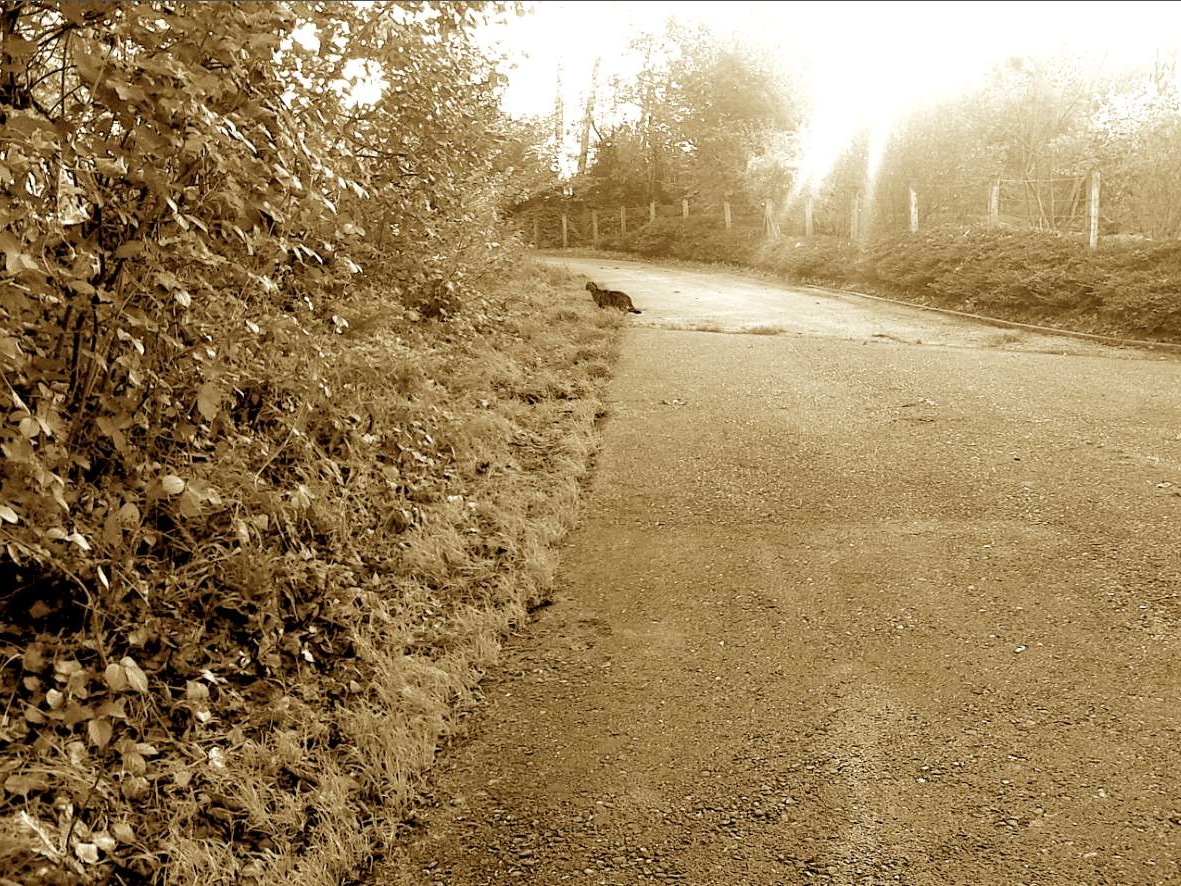 (Pictures: DS) |
A painting is going to travel. To Madrid, this is for sure, and subsequently to Washington (see Basler Zeitung, September 2, 2014, p. 19). And then? Will it come back to Basel? We don’t know yet. Which means: now is the time to throw a last glance at a picture that has caused controversy (http://en.wikipedia.org/wiki/Daubigny's_Garden). For some a Van Gogh pastiche/copy/forgery by Émile Schuffenecker (http://en.wikipedia.org/wiki/Émile_Schuffenecker). For others one of the works by Vincent van Gogh, one of the five works to be seen in Basel Kunstmuseum. We head to Kunstmuseum Basel, but taking a longer detour. By taking a walk to see villas and gardens, and a walk to think. About villas and gardens, and only a little about attributions, and finally our walk will lead us to the picture in question itself.
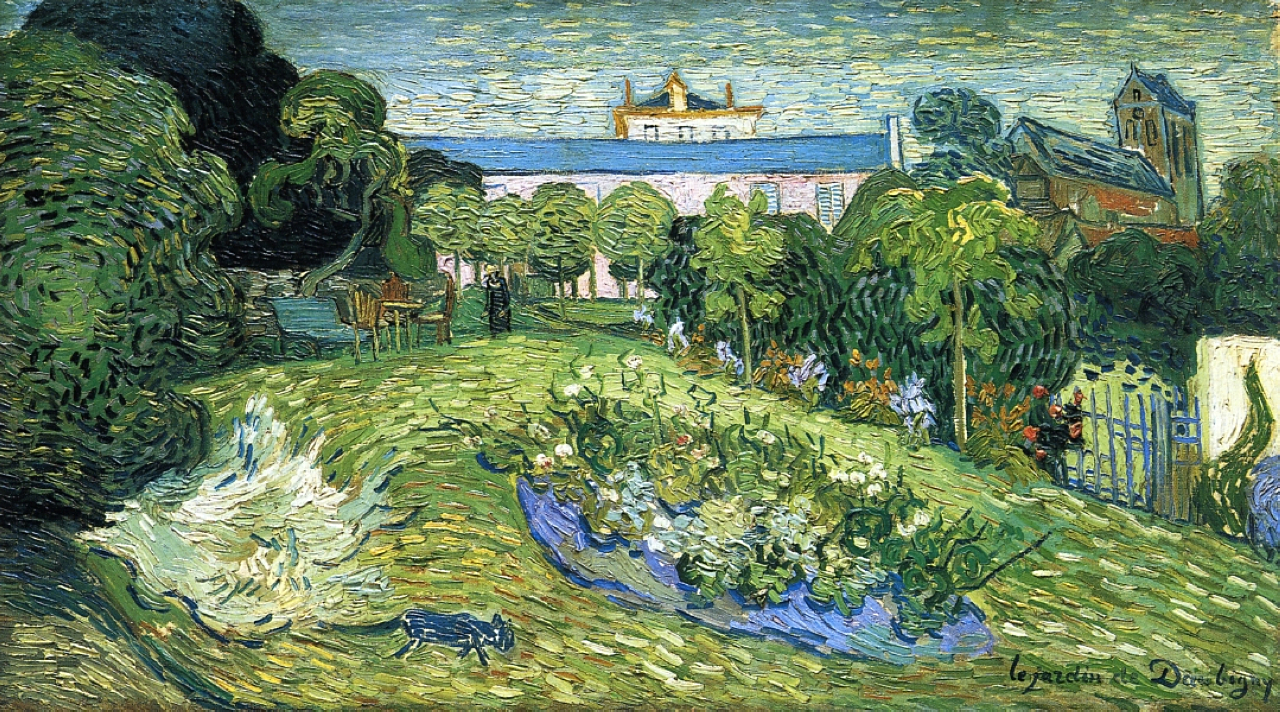 |
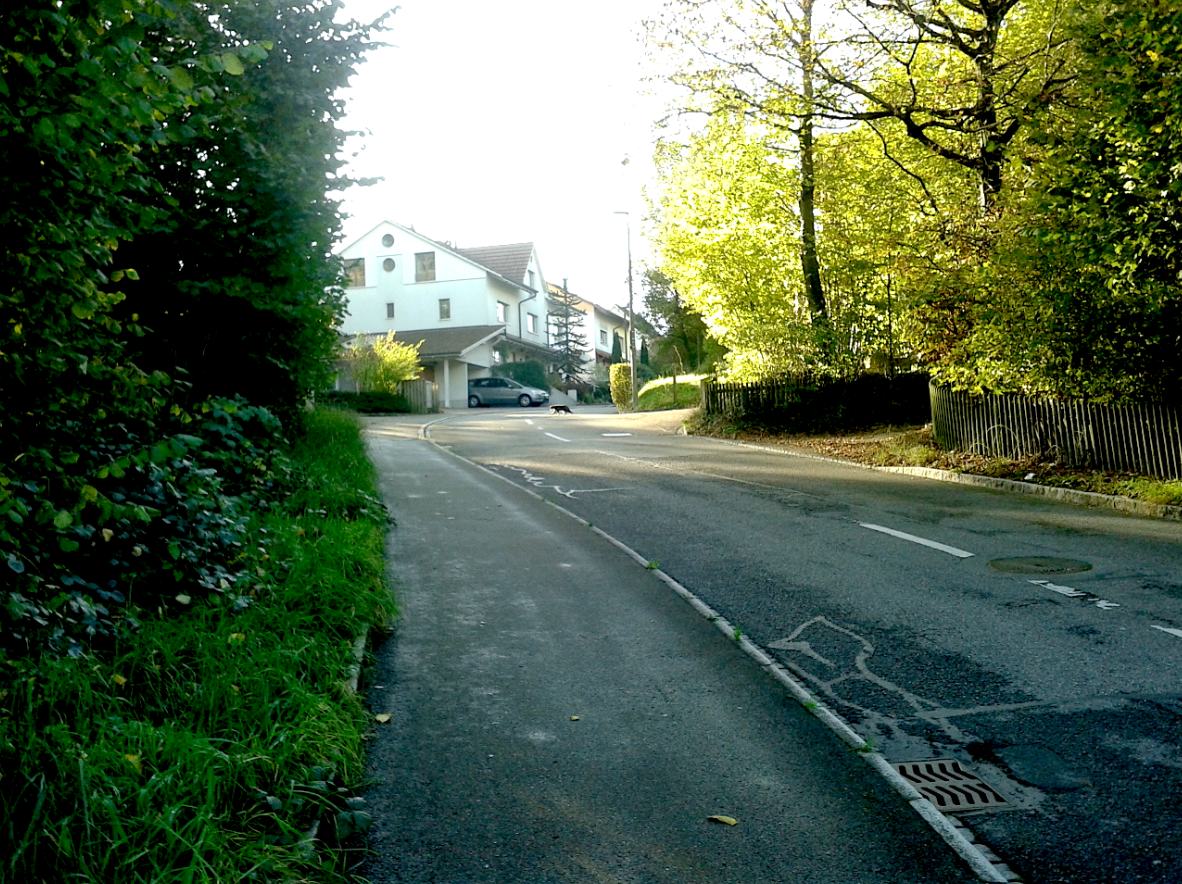
(Picture: DS)
All in all I have encountered three cats on my walk (one black), not to forget the twice seen missing cat report (name: Tom). Gardens I have seen many (from outside). Most inviting was a self-pick flower garden (more of a field, but we might accept it as a garden nonetheless). Less inviting the many villa gardens (security). Carrying around a photo camera immediately might turn us into a suspect, even, or even more so, if we are claiming this to be for art historical reasons (but nobody did ask me anyway).
It’s not his ›best‹ picture that Vincent van Gogh is referring to in his last letter to his brother Theo. It is one of his ›most deliberate‹ (»une de mes toiles les plus voulues«). And this strikes me as the actual important point of departure here. Because, frankly, I could live with both versions of Le Jardin de Daubigny turning out to be by Schuffenecker, the sketch is better anyway (and has this possibility, by the way, ever been considered at all?).
But seriously. We have something to work with, and this is the fact that Le Jardin de Daubigny was an ambitious project of Van Gogh. And this in the very last weeks of his very existence. We have the sketch from the letter of July 23 (2r). And what is wrong with having several attempts to realize what Van Gogh actually had in mind (even if both versions would strike us as being rather ›deliberate‹, which could also be pointed out as ›stiff‹, ›inhibited‹ or ›rather being a deliberate construction than deliberate brushstroke music‹)? But again: the point I am getting at is: What did Van Gogh actually have in mind? What does ›deliberate‹ mean here? And if one thing is certain: it is not about solving a mysterious puzzle of attribution here, or about defending the Basel version of Le Jardin de Daubigny against the Hiroshima version. Others have done that (in my eyes not always convincingly; and the Basel libraries, by the way and much to my chagrin, have not acquired the Schuffenecker oeuvre catalogue), but for the moment it is about drawing attention to the notion of ›deliberate‹ and to think about what directions a deliberate attempt to render a garden might take.
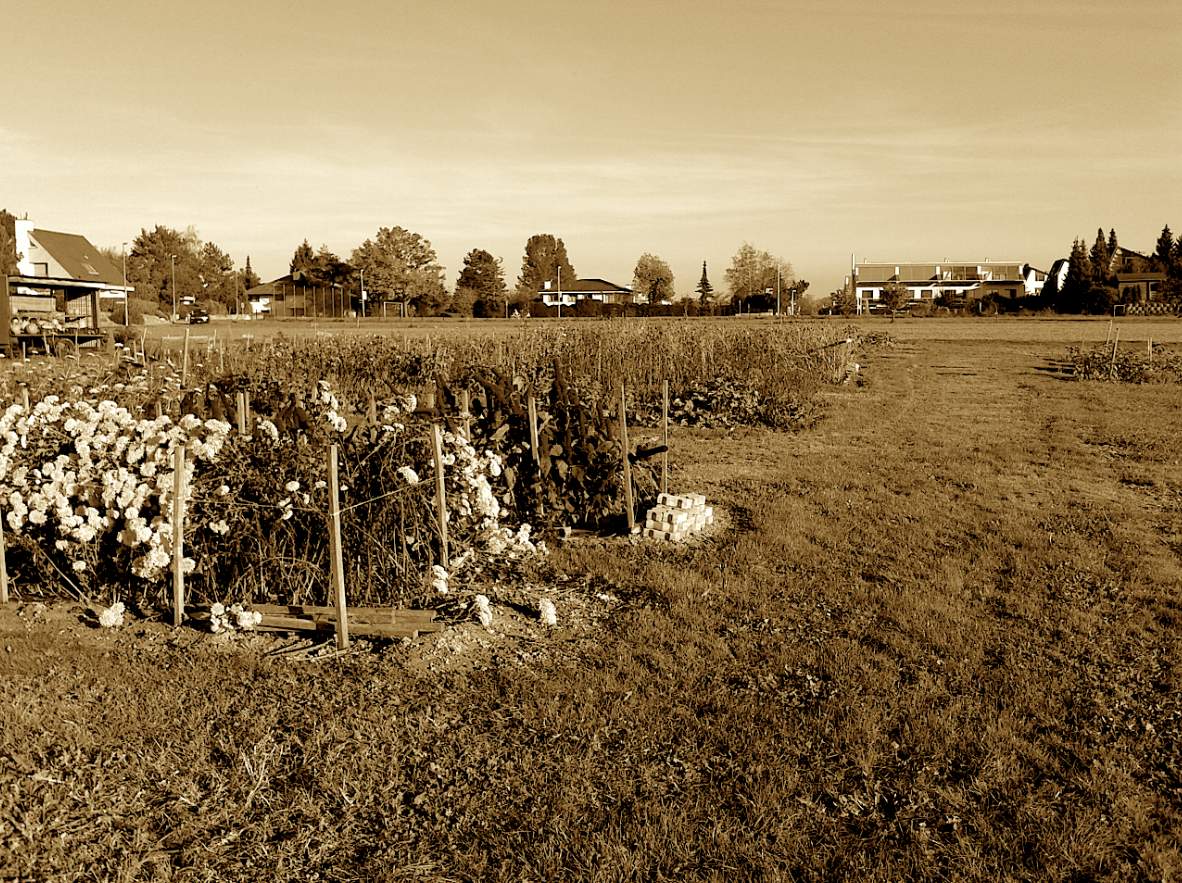
(Picture: DS)
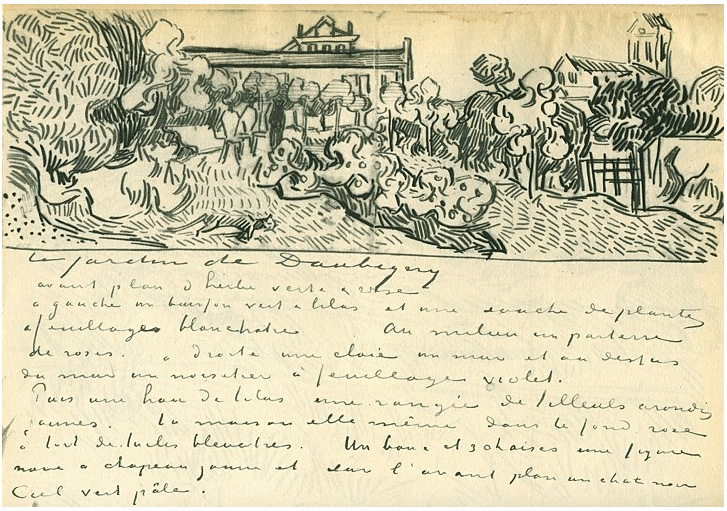 (Picture: vangoghgallery.com) |
Thinking about being a suspect, a potential burglar, might at least be useful for one thing: To recall that every garden, as inviting it might be, is a seclusive garden. It is part of the very definition of garden that the garden is somehow protected or at least defined as something being part of ›civilisation‹ (in opposition to something else, the outside, the public space, the property of others, the wilderness of society, the wilderness).
Little surprising that on my walk I had the chance to see a flock of crows scared away by a horse that was coming out on a field, but as someone not being a villa owner I had’t the chance to see a garden from the perspective that the painter of Le Jardin de Daubigny saw this very garden. Because for this, one has to be not only a visitor, but an actual invitee. The villa of Daubigny is seen from one corner of its very garden, from an actual niche, where also a cat acts as if not being disturbed at all. And now, what I had not realized for quite some time, although I know the picture for some time, the view from the garden’s very corner at the house is indeed a very deliberately chosen view. And the composition, if it is supposed to work, requires also a certain precision, if it is meant to show that the beholder of the picture is actually positioned in one specific part of the garden, in one niche, but also led to imagine, if the eye follows the contour lines of the meadow, another part of the garden, closer to the house (one might imagine a lying x or lying 8. And only if becoming aware of the very basic ground plan we actually get a sense of the geography we’re in, a geography, however, that is not spelled out to us (the sketch has a curve leading more deliberately towards the church and organizes space by having appear trees in various sizes), but only alluded to by the crossing lines in one rather small, but, as to the composition, crucial segment of the picture’s plane where the lines actually do intersect.
Where we are right now, we remain a guest, we see that the house might, with a bench, a table and several garden chairs also be prepared for having more guests, but for the moment we prefer not to walk the garden’s paths but to feel immersed, being in our very niche, within this almost park-like landscape, immersed but still with having a feel for the whole, the bird’s perspective, the church nearby, the sky, in sum: of the various openings of the very seclusive garden that lead also to another, a neighbor’s garden possibly, and possibly also to the churchyard. And right in front of us not only a cat but also a rose bed.
 |

 |
A mix of artificial museum’s light combined with the rest light of a late fall afternoon (winter time) was on the picture, when I finally got to it. From the very cabinet’s window, by the way, one can see also the artificial lights on the very top of the big wheel on Petersplatz that reminds us that presently it’s days of the Basler Herbstmesse (fall exhibition).
The light flattered the painting that, in reproduction, might sometimes appear rather awkward and chaotic, but, whosever merit is this, it is not (but just the result of very deliberate thinking). And I am thinking also now that the painting might only look somewhat awkward, if one does look at it rather superficially, interpreting it, superficially, as merely a frontal view upon a house, not realizing the before mentioned curved line (that alludes to the more general garden architecture, and the complicated arrangement of round shaped trees, a bed of roses, island-like, in the foreground, being a substructure within ›our‹ part of this garden, in our, for the moment, almost private seclusive garden, while from two sides two waves of vegetations announce, although being static, movement and interaction between left and right and underscore the feeling of beeing immersed in (civilised?) nature. And more than that: although the composition is quiet, there is slight movement with one human figure appearing and with one cat (stretched, but not overstretched) passing as if preparing for hunting actions. But not as dramatic a movement, all in all, to disturb a contemplation of, yes, all things.
The contemplating of a garden, all in all, from the position of someone that has withdrawn, but still registering very attentively what is going on, might fill the rest of day, and maybe also include the expecting of the day’s light to fade. The mix of artificial museum’s light with a rest of day light resulted, on my visit, with slight reflections on the single brushstroke, i.e. on the whole relief of paint, and made it a charming picture to look at for quite some time (and undisturbed, at this rather late hour, for quite some time). Not necessarily from very close by, because the composition, as I mentioned, is complicated and carefully thought of, and also because of inspecting the shape of the cat and also the drawn letters of the title might recall, involuntarily, the question of attribution (the letters of the title were written on dried and thus hardened out green brushstrokes and on not quite dried out pinkish white brushstrokes which resulted in some of the letters being lighter than the others; but since we are not into questions of attribution here, let us regard this clue as just another hint that the composition was indeed a carefully thought out and also ambitious project, worth of being reworked, worth of being finished, if still possible, in a studio, and maybe worth of being repeated (mainly because the house, compared with the composition of the sketch, resulted twice too big, given the format, got also too much in the center and did not leave enough space for the ›stuffed in‹ church on the right; and if I was supposed to believe that the sketch was made after, i.e. on basis of the Basel painting (or the Hiroshima painting) I would have to say no, that I do not believe that). Nevertheless and in spite of the Schuffenecker suspicion: a project, a composition much worth to be thought about, on a bright day in fall and on a walk. (30./31.10.2014)
PS: Since fakers have recently lectured art historians of not having joined forces to detect forgeries, we are inclined to ask forgers to unite now and to deliver an unknown, supposedly ›lost original‹ of Le Jardin de Daubingy (I wonder anyway why, until the present day, no such ›lost original‹ has come up yet), and if it is not too much to ask: please without falling back behind the merits of the two known versions, but more in accordance with the sketch, especially as for the organization of space.
 (Picture: vangoghgallery.com) |
 |
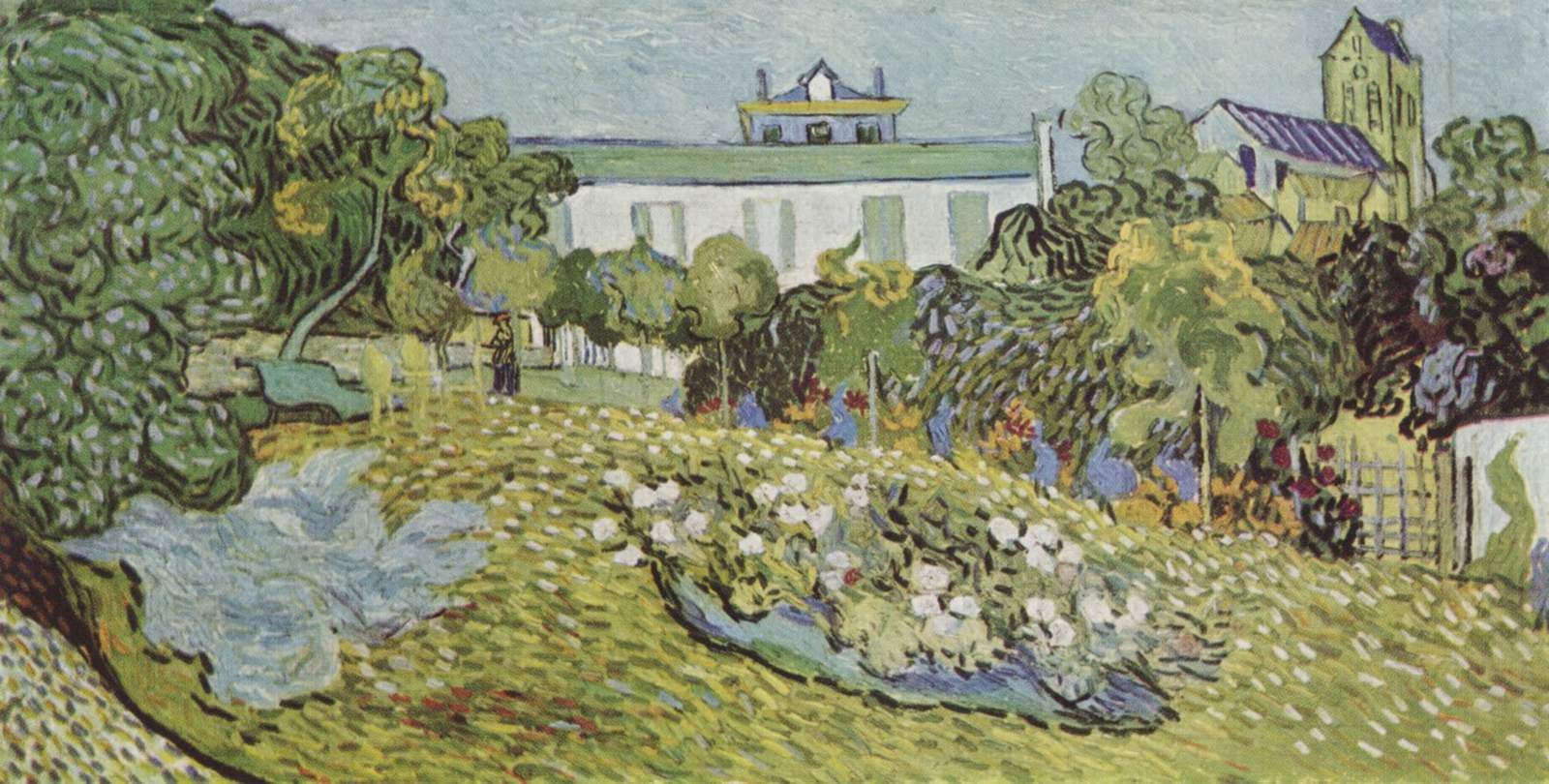 |
    Vincent van Gogh: Sketch of Le Jardin de Daubigny (detail), letter of 23 July 1890, 2r 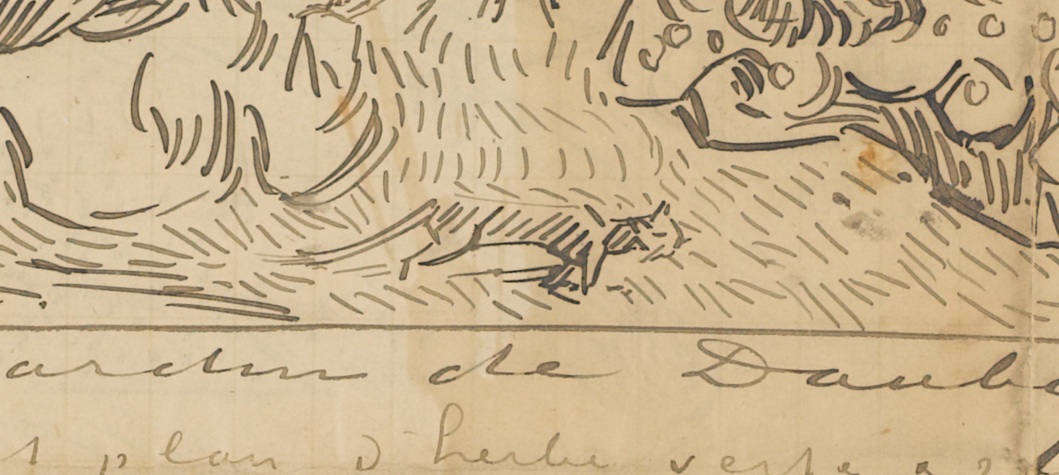 (Source: vangoghletters.org; small pictures: DS, vangoghgallery.com, wikipaintings.org, hiroshima-museum.jp; bg picture: DS) |
*
A Supplement: Two Photographs
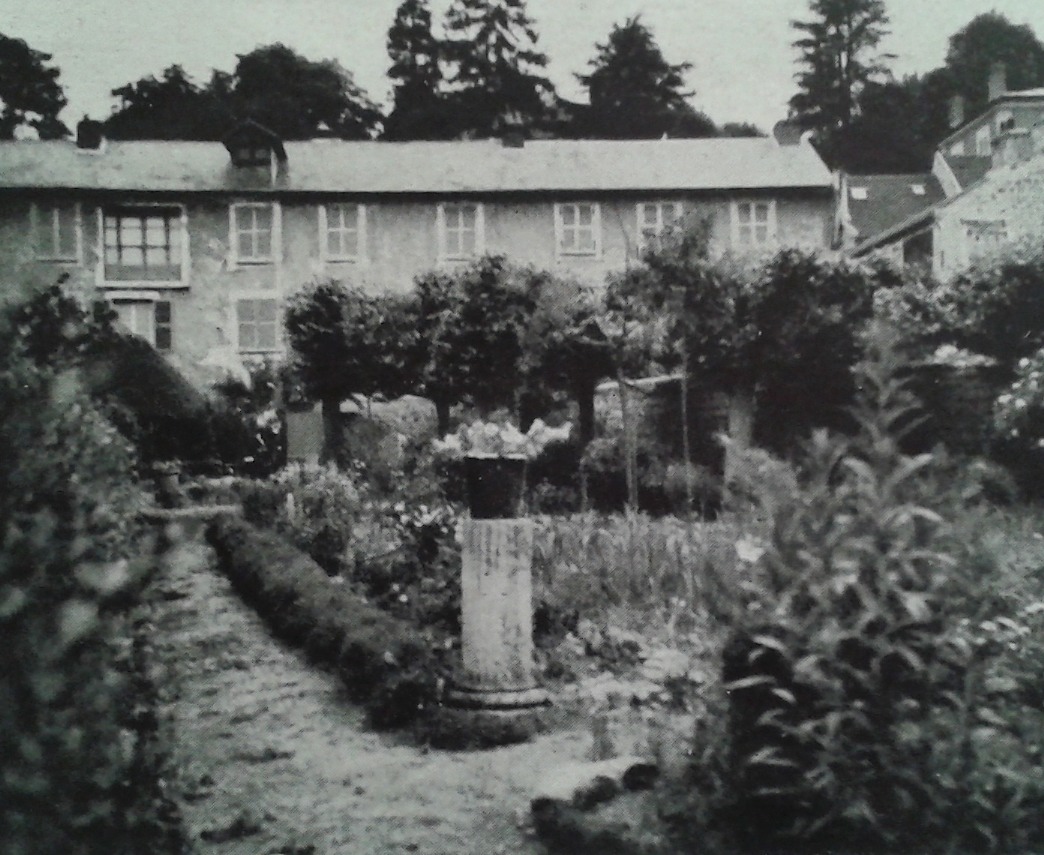
The Jardin de Daubigny in 1935, as photographed by Walter Ueberwasser
(Source: Walter Ueberwasser, Le jardin de Daubigny. Das letzte Hauptwerk Van Gogh’s, Basel 1936, p. 29):
»Garten und Baumallee steigen schräg an. Man beachte Fenstergrösse und -zahl[.] Die Villa Richard ist heute [1936] von den emporgewachsenen Tannen verdeckt.«
 (Picture: vangoghgallery.com) |
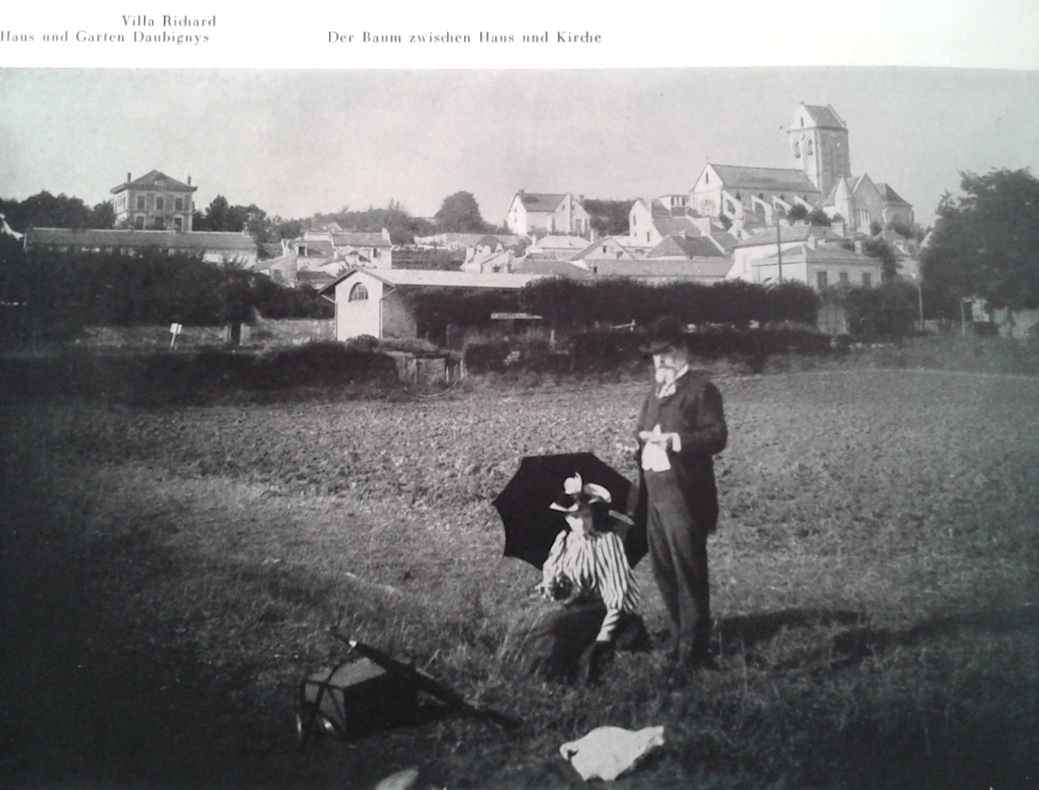
A photograph of Auvers-sur-Oise, owned by Dr. Gachet
(Source: Walter Ueberwasser, Le jardin de Daubigny. Das letzte Hauptwerk Van Gogh’s, Basel 1936, p. 26):
»Man beachte die auf beiden Seiten des Kirchturms verschieden grossen Glockenfenster, sowie die Längsschatten auf dem etwas eingesunkenen Kirchendach.«
PS: A few further random thoughts
1) Of course it has not escaped scholars’ notice that the composition of the sketch is not at all in accordance with the composition of the two painted versions (although one reads also the claim that the paintings were ›more or less‹ in accordance with the sketch). This gap is explained by the assumption that Van Gogh did sketch from memory and used also another format.
From my point of view this does not make sense at all: Vincent van Gogh was aiming to inform his brother Theo, with a description and a sketch, about a painting that he had thought of very carefully during the last weeks of his life, a painting that was still with him at the time of writing, and the purpose, again, of the letter was to inform. Does it hence make sense, if he sketched something completely different? Something new? With a church not ›stuffed in‹, but given at right, within a completely balanced composition, with the house not centered, but seen slightly from the right, a composition that is also not done very quickly (because Van Gogh did not only take his time to define numerous volumina of trees very carefully (with also overlapping sizes because of the distances), but by doing this also to define a rather complicated topography very precisely (not to mention the cat’s whiskers which are not missing).
2) If it is assumed that the ›one original‹ (to whatever version this is referring to) was done within four days of time (as the letters seem to suggest, albeit only to some), such a time frame is not in accordance with the dried out pastose brushstrokes upon which the title is written in the Basel version. And one has, by the way, also to remember that canvas has been added to the Basel version on top and later (which means: this version is not, although this remains usually unsaid, by one single hand anyway).
3) If orthodoxy does claim that Van Gogh painted one version ›after nature‹ (to whatever version this assumption is referring to) one has at least to take a very deliberately ›constructive‹ element into account, since it is highly likely that from the point of view of the painter, and given the topography of Auvers-sur-Oise, the church could not be seen at all, because it was simply out of frame, and without any doubt the church could not be seen as the church is seen in the two painted versions.
This final point reminds also why attribution does actually matter: because attributions contribute to ›define‹, or, respectively, go along with a ›defining‹ of artistic personality in one way or another: here, for example, as either ›protocolling nature‹ or, more in accordance with what Vincent van Gogh said himself in his letters as to this one project: as working very deliberately.
And, again, if he was working very deliberately here, we cannot ignore that, in the sketch, and compared with the two versions, he was doing something completely different, giving a different solution to a compositional problem, compared with the solutions offered by the hands of the two paintings (which does not at all exclude his authorship as for the two painted versions, or for one, but leads one to think that the two versions might reflect rather an early stage of searching how to solve a compositional problem).
 |
 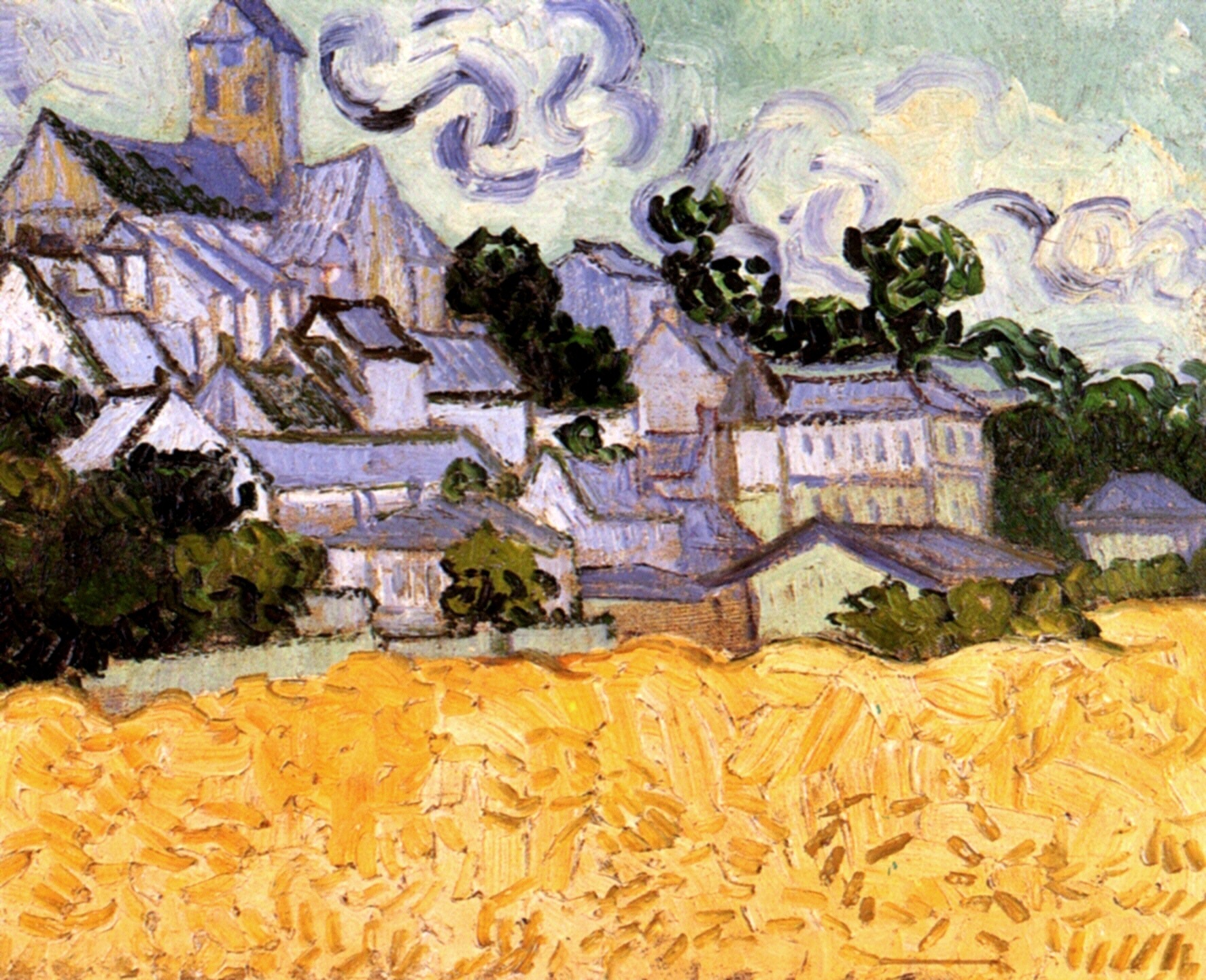 (Picture on the right: wikiart.com) |
| MICROSTORY OF ART ONLINE JOURNAL FOR ART, CONNOISSEURSHIP AND CULTURAL JOURNALISM A Last Glance at Le Jardin de Daubigny  (Pictures: DS) |


MICROSTORY OF ART
ONLINE JOURNAL FOR ART, CONNOISSEURSHIP AND CULTURAL JOURNALISM
HOME
© DS